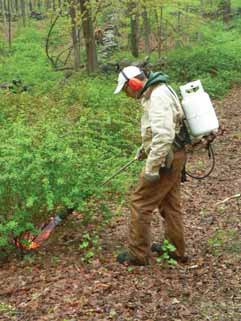The more researchers learn about barberry, the more they find to dislike about it. The thorny perennial shrub escaped from cultivated landscapes after being introduced to the U.S. in the 1880s, and now it is established in 31 states and considered an invasive in most of them, where it is becoming a dominant understory shrub.
Primarily spread by birds eating the berries and defecating the seeds, barberry survives well in the dense shade and slowly creeps across the forest. Dense barberry stands have been found to reduce the regeneration of desirable trees, alter nitrogen cycling in the soil, and double the number of earthworms, which can lead to a loss of the duff layer on the forest floor and negatively affect wildflowers, salamanders, and water quality.
Recent research by Jeff Ward and colleagues at the Connecticut Agricultural Experiment Station has found that blacklegged ticks, which carry several disease causing pathogens, including Lyme disease, are more abundant in large barberry patches than elsewhere in the forest, but that barberry control efforts can reduce tick numbers by 75 percent within two years.
Those results further emphasize the importance of figuring out how best to get rid of the unwanted shrub. Ward and his team have experimented with 48 different treatment combinations in the last four years to identify the most effective barberry control methods using the least amount of chemical herbicide.
“The typical way to control barberry in the past has been to pull it up by hand, but when you do that you expose a lot of mineral soil, which means you let in new barberries and other invasives,” Ward said. “Herbicide works, but we’re trying to find a way to minimize its use.”
The answer, they found, is to begin by mechanically mowing the barberry with a brush saw or rotary mower in the spring to reduce the size of established clumps. When it resprouts about six weeks later, Ward advises using a propane torch to kill it off for good.
“And if the first treatment doesn’t kill it, then hit it with the torch again,” he said. “Propane followed by propane is the way to go.”
When compared with a follow-up application of herbicide, Ward said that two treatments using a propane torch were just as effective and the cost of materials was about the same. He noted, however, that it takes about four times as many man hours to torch the sprouts as to apply herbicide.
“When they’re big and living in the sun, you may have to go back two or three times with a torch to finish the job, but with herbicide you can get most of it with one pass. That’s the big difference,” Ward said. “But the torch is still the best option in sensitive areas.”



Discussion *